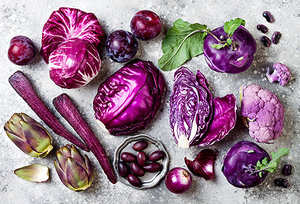All About the Purple
By Editorial Staff
We're talking about purple vegetables and tubers (purple carrots, purple potatoes / sweet potatoes, etc.), and research suggests eating more of these pigmented foods can help reduce your type 2 diabetes risk.
The key compound in these foods:
acylated anthocyanins, which help increase energy metabolism and gut microbiota while reducing inflammation. Let's look at new research to see why this compound is so important when it comes to diabetes.
Researchers investigated the anti-diabetes properties of acylated anthocyanins (which account for the red-orange to blue-violet color of many veggies and tubers) in a study published in the Journal of Agricultural and Food Chemistry. Compared to non-acylated anthocyanins (berries are a major dietary source of the non-acylated type), acylated anthocyanins appear to be more stable and bioavailable, improving their efficiency.
 So, how does this compound help reduce type 2 diabetes risk, according to the researchers? Risk factor #1: Blood sugar so high that it cannot be consistently reduced via insulin. Acylated anthocyanins appear to reduce blood glucose levels. Risk factor #2: Inflammation caused by insulin resistance. Acylated anthocyanins decrease activation of NF-κB, a primary driver of insulin resistance due to inflammation. Risk factor #3: Gut microbiome dysfunction affecting glucose tolerance and insulin resistance. Acylated anthocyanins are extensively metabolized by gut microbiota, improving microbiome health relative to various diabetes risk factors.
So, how does this compound help reduce type 2 diabetes risk, according to the researchers? Risk factor #1: Blood sugar so high that it cannot be consistently reduced via insulin. Acylated anthocyanins appear to reduce blood glucose levels. Risk factor #2: Inflammation caused by insulin resistance. Acylated anthocyanins decrease activation of NF-κB, a primary driver of insulin resistance due to inflammation. Risk factor #3: Gut microbiome dysfunction affecting glucose tolerance and insulin resistance. Acylated anthocyanins are extensively metabolized by gut microbiota, improving microbiome health relative to various diabetes risk factors.
Are you getting enough anthocyanins in your daily diet in the form of purple and similarly pigmented vegetables and tubers? Are you eating enough healthy food in the first place? If you're at risk for type 2 diabetes, it's time to start. Ask your doctor for more information on the right diet to keep type 2 diabetes out of the picture.

